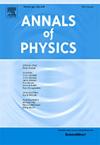时变Aharonov-Bohm效应与四维Stokes定理
IF 3
3区 物理与天体物理
Q2 PHYSICS, MULTIDISCIPLINARY
引用次数: 0
摘要
随时间变化的Aharonov-Bohm (AB)效应考虑了螺线管内磁通量随时间变化的情况。与标准的ab效应不同,这个问题出乎意料地微妙,不容置疑地不容易解决,这就是为什么它即使在理论上也仍处于不确定状态的原因。其难点在于其理论分析需要在四维闵可夫斯基空间中沿路径对随时间变化的矢量势进行线积分。根据四维斯托克斯定理,矢量势的闭合线积分可以与二维区域上电场和磁场的积分联系起来,二维区域的边界由上述闭合路径给出。争论的核心是Singleton及其合作者基于四维Stokes定理的主张的成功或失败,该定理指出,由于磁矢量势引起的ab相移的时变部分被磁通量的时变产生的感应电场的影响精确地抵消了。在本文中,我们通过回到带电粒子运动的基本量子力学分析,并结合对四维斯托克斯定理的更仔细的处理,仔细地重新分析了他们的抵消论点。对四维斯托克斯定理的仔细分析表明,Singleton等人的消去论点部分正确,但他们的中心主张,即只有磁场的时间无关部分有助于ab相移,因此不存在时间相关的ab效应,这是不合理的,因此支持可能存在时间相关的ab效应。本文章由计算机程序翻译,如有差异,请以英文原文为准。
On the time-dependent Aharonov–Bohm effect and the 4-dimensional Stokes theorem
The time-dependent Aharonov–Bohm (AB) effect considers the situation in which the magnetic flux inside the solenoid changes time-dependently. Different from the standard AB-effect, the problem is unexpectedly subtle and not easy to solve without any doubt, which is the reason why it is still in a state of unsettlement even theoretically. The difficulty originates from the fact that its theoretical analysis requires line-integrals of the time-dependent vector potential along paths in the 4-dimensional Minkowski space. Owing to the 4-dimensional Stokes theorem, this closed line-integral of the vector potential can be related to the integral of the electric and magnetic fields over the 2-dimensional area, the boundary of which is given by the above-mentioned closed path. The central controversy concerns the success or failure of the claim by Singleton and collaborators based on the 4-dimensional Stokes theorem, which states that the time-dependent part of the AB-phase shift due to the magnetic vector potential is precisely cancelled by the effect of induced electric field generated by the time-variation of the magnetic flux. In the present paper, we carefully reanalyze their cancellation argument by going back to the basic quantum mechanical analysis of the charged particle motion under the presence of the time-dependent external electromagnetic potential combined with more careful treatment of the 4-dimensional Stokes theorem. Careful analysis of the 4-dimensional Stokes theorem shows that the cancellation argument by Singleton et al. is partially correct but their central claim that only the time-independent part of the magnetic field contributes to the AB-phase shift so that there is no time-dependent AB-effect is not justified, thereby supporting likely existence of the time-dependent AB-effect.
求助全文
通过发布文献求助,成功后即可免费获取论文全文。
去求助
来源期刊

Annals of Physics
物理-物理:综合
CiteScore
5.30
自引率
3.30%
发文量
211
审稿时长
47 days
期刊介绍:
Annals of Physics presents original work in all areas of basic theoretic physics research. Ideas are developed and fully explored, and thorough treatment is given to first principles and ultimate applications. Annals of Physics emphasizes clarity and intelligibility in the articles it publishes, thus making them as accessible as possible. Readers familiar with recent developments in the field are provided with sufficient detail and background to follow the arguments and understand their significance.
The Editors of the journal cover all fields of theoretical physics. Articles published in the journal are typically longer than 20 pages.
 求助内容:
求助内容: 应助结果提醒方式:
应助结果提醒方式:


